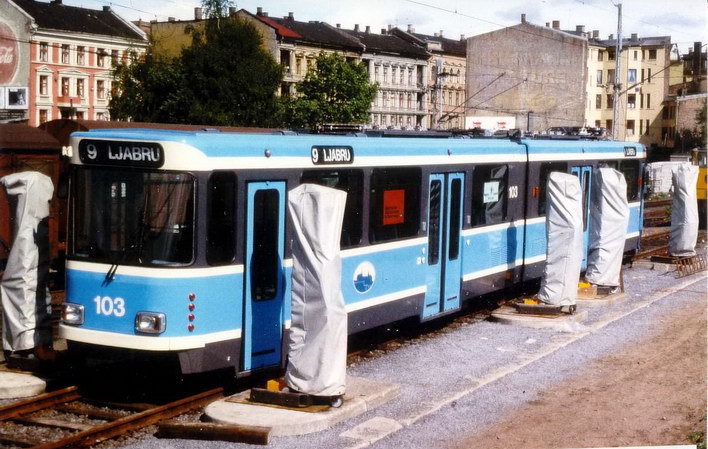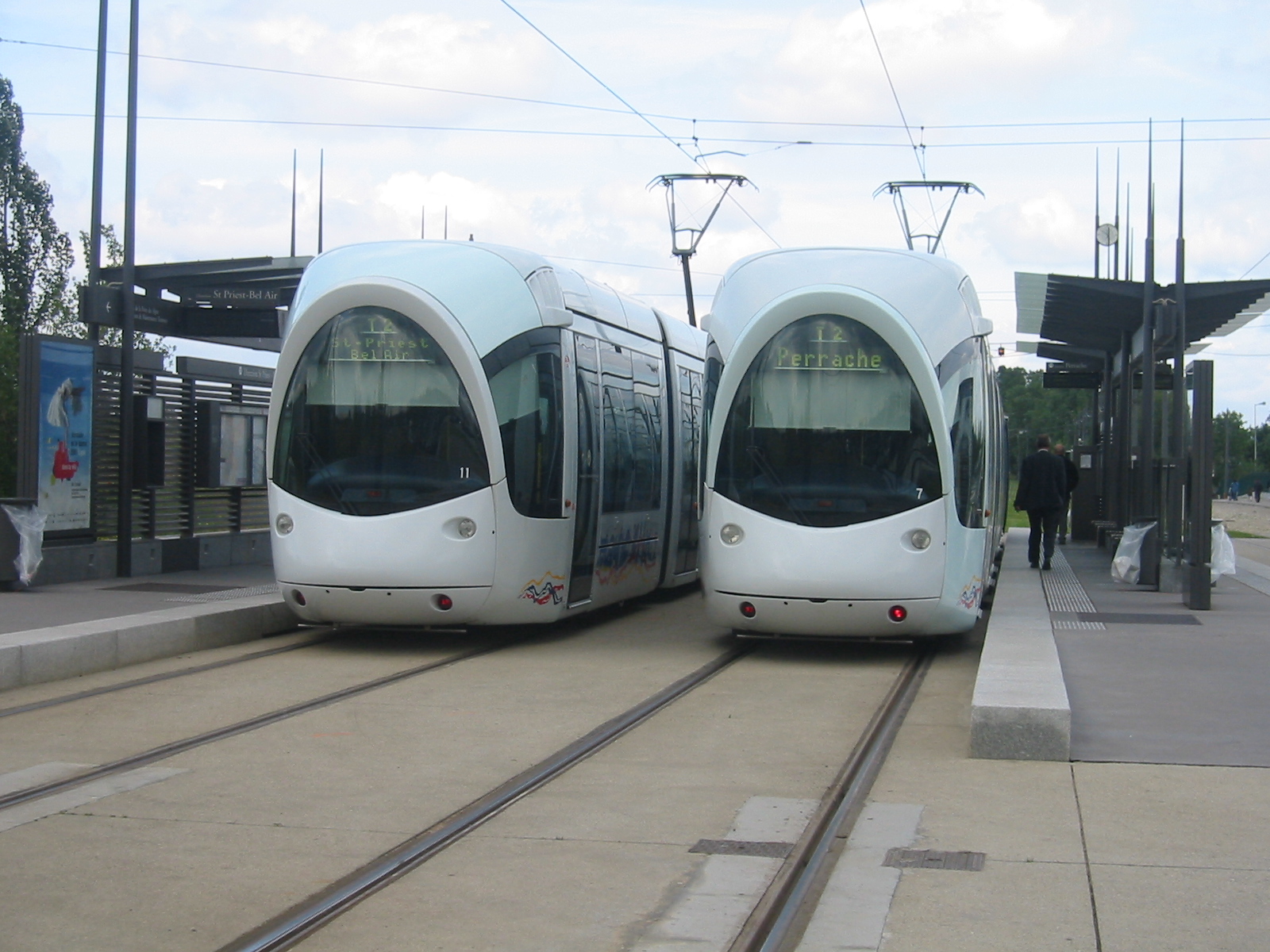|
Disen Tram Stop
Disen is a tram stop located on the Oslo Tramway, Oslo Tramway network. Located in Nordre Aker in northern Oslo, the station is part of the Kjelsås Line, that operates between Storo station, Storo and Kjelsås tram stop, Kjelsås. Disen also has a balloon loop, for trams to turn around and change direction. However, trams do not regularly terminate at Disen anymore. Disen was opened on the 25th September, 1934. Disen was also closed along with Kjelsas Line between 2002 and 2004. Service Disen is served by Trams_in_Oslo#Line_11, Line 11 and Trams_in_Oslo#Line_12, Line 12 of the Oslo Tramway network. Line 11 and 12 both have their westbound terminus at Majorstuen (station), Majorstuen and eastbound terminus of Kjelsås tram stop, Kjelsås. Night bus routes 11N and 12N also serve the station during the night period which lasts between 2 AM and 6 AM. Disen is also approximately 600 metres from Storo station, Storo's metro station and approximately 850 metres away from Grefsen station ... [...More Info...] [...Related Items...] OR: [Wikipedia] [Google] [Baidu] |
SL79
SL79 is a class of 40 articulated trams operated by the Oslo Tramway of Norway. The trams were a variation of the Duewag trams that had been developed by the German manufacturer since the 1950s. The six-axle vehicles are unidirectional with four doors on the right side. The trams can seat 77 passengers three and four abreast, with an additional 91 people able to stand. Power output is , provided by two motors on the two end bogies, that supplement a central unpowered Jacobs bogie located under the articulation. The trams are long and wide. They are capable of and have standard gauge. They were built in two series, the first of 25 units delivered in 1982–84, and the second of 15 units delivered in 1989–90. The first 10 units were built by Duewag, while the last 30 were built in Norway by Strømmen. They were numbered 101 through 140. The two series vary slightly in specifications. The trams were ordered in 1979 after the 1977 decision to not close the tramway, after the SM53 ... [...More Info...] [...Related Items...] OR: [Wikipedia] [Google] [Baidu] |
Storo Station
Storo is a rapid transit station on the Ring Line of the Oslo Metro, and a tram station on the Grünerløkka–Torshov Line of the Oslo Tramway. It is located at Storo in the Nordre Aker borough of Oslo, Norway. The tram station opened on 28 November 1902, and the rapid transit station on 20 August 2003. Metro lines 4 and 5 run to the station. The tram station serves lines 11, 12 and 18. The station is within walking distance of Grefsen Station on the Gjøvik Line. The station also functions as a bus hub, being located along Ring 3 (Oslo), Ring 3. Storo is a mixed commercial and residential area, and a shopping center is located just north of the subway station. History Storo opened as a tram station as the terminus of the Grünerløkka–Torshov Line on 28 November 1902. The line was extended northwards as the Kjelsås Line to Kjelsås tram stop, Kjelsås on 25 September 1934, and south-eastwards as an extension of the Sinsen Line in 1939. The process of establishing a Ring ... [...More Info...] [...Related Items...] OR: [Wikipedia] [Google] [Baidu] |
SL18
The SL18 ''(short for Sporvogn Ledd, commissioned in 2018)'' is a series of 87 low-floor, articulated trams currently being phased-in on the Oslo Tramway network. They will continue to be phased-in until 2024, when the last SL79s and SL95s are replaced. They were purchased from the Spanish tram manufacturer, CAF. The first one was shipped and unveiled at Grefsen depot in 2020, and regular operation begun in 2022. The entire purchase has a price of 4.2 billion krones. There is also a possibility of acquiring another 60 more trams from CAF. History By 2009, it was recognised that the city of Oslo needed new trams and that the rail infrastructure needed to be upgraded. In 2013, the City Council of Oslo initiated the tram program. The responsabilty of procurement was transferred to Sporveien in August 2015. In December 2015, the Council approved the procurement of 87 new trams. Also in December 2015, the pre-qualification of suppliers began and the potential suppliers were announ ... [...More Info...] [...Related Items...] OR: [Wikipedia] [Google] [Baidu] |
Majorstuen (station)
Majorstuen is a subway station on the Oslo Metro and a tram stop on the Briskeby Line of the Oslo Tramway. It is located in the Majorstuen neighborhood in the Frogner borough. Majorstuen is shared by all the subway lines, and, being located just after the tunnel entrance, it is the only such station not located underground. Majorstuen was originally the end station for Holmenkollbanen, and remained so until the tunnel to Nationaltheatret Station was completed. After Majorstuen the subway lines split up in three directions. Sognsvannsbanen runs northwards, Holmenkollbanen runs to the northwest while Røabanen and Kolsåsbanen are on a shared track to the west. The station has three platforms. There are two main platforms facing each other. Behind the platform for outbound trains is a bay platform, used for the trains on the west side of Oslo which terminate at Majorstuen. Such trains are not common, they are usually early-morning trains or trains which are retiring for the eve ... [...More Info...] [...Related Items...] OR: [Wikipedia] [Google] [Baidu] |
Trams In Oslo
The Oslo tram network ( no, Trikken i Oslo, short from ', 'electric') is the tram system in Oslo, Norway. It consists of six lines with 99 stops and has a daily ridership of 132,000. It is operated by , a subsidiary of the municipally-owned who maintain the track and 72 tram vehicles on contracts with the public transport authority . The system operates on standard gauge and uses 750 V DC overhead. Depot, workshops and headquarters are at (at the terminus of lines 13 and 17). There is also a depot at (along lines 18 and 19) that is home to the technical company InfraPartner, which maintains the track for the tram and metro systems in Oslo, and a small office building for . History The first tram in Oslo was opened in 1875 with a short line between Homansbyen west of the city centre, Oslo West Railway Station and a sideline to Grønland, east of the city centre. The first "trams" were in fact horse-drawn vehicles on flanged steel wheels. The first expansion of the line cam ... [...More Info...] [...Related Items...] OR: [Wikipedia] [Google] [Baidu] |
Kjelsås Tram Stop
Kjelsås, sometimes called Kjelsaas, is one of the northern neighbourhoods of Oslo situated in Nordre Aker, the northern borough of Oslo, Norway. History Together with Grefsen, Kjelsås was part of the borough ''Grefsen-Kjelsås'' until January 1 2004, when they both became part of the new borough of Nordre Aker. Grefsen and Kjelsås were also part of the former municipality of Aker before the second world war, when the City of Oslo was confined to today's central areas. Geography The district of Kjelsås offers ski jumps, slalom slopes and vast woodland areas for hiking. Lake Maridalsvannet, located close to the woodlands, provides Oslo with its drinking water and is also the source of the Akerselva river, (formerly Frysjaelven). Akerselva is the dividing line between many areas of Oslo including the northern suburbs. Traditionally seen as Eastern or Western Oslo depending on which side of the river one is on. This distinction is even found in the name of the river. Ake ... [...More Info...] [...Related Items...] OR: [Wikipedia] [Google] [Baidu] |
Oslo Tramway
The Oslo tram network ( no, Trikken i Oslo, short from ', 'electric') is the tram system in Oslo, Norway. It consists of six lines with 99 stops and has a daily ridership of 132,000. It is operated by , a subsidiary of the municipally-owned who maintain the track and 72 tram vehicles on contracts with the public transport authority . The system operates on standard gauge and uses 750 V DC overhead. Depot, workshops and headquarters are at (at the terminus of lines 13 and 17). There is also a depot at (along lines 18 and 19) that is home to the technical company InfraPartner, which maintains the track for the tram and metro systems in Oslo, and a small office building for . History The first tram in Oslo was opened in 1875 with a short line between Homansbyen west of the city centre, Oslo West Railway Station and a sideline to Grønland, east of the city centre. The first "trams" were in fact horse-drawn vehicles on flanged steel wheels. The first expansion of the line came ... [...More Info...] [...Related Items...] OR: [Wikipedia] [Google] [Baidu] |
Balloon Loop
A balloon loop, turning loop, or reversing loop ( North American Terminology) allows a rail vehicle or train to reverse direction without having to shunt or stop. Balloon loops can be useful for passenger trains and unit freight trains. Balloon loops are common on tram and streetcar systems. Many streetcar and tram systems use single-ended vehicles that have doors on only one side and controls at only one end. These systems may also haul trailers with no controls in the rear car, and, as such, must be turned at each end of the route. History Balloon loops were first introduced on tram and, later, metro lines. They did not commonly appear on freight railways until the 1960s, when the modernising British Rail system introduced '' merry-go-round'' (MGR) coal trains that operated from mines to power stations and back again without shunting. Tramways On the former Sydney tram system, loops were used from 1881 until the second-generation system's closure in 1961. Initia ... [...More Info...] [...Related Items...] OR: [Wikipedia] [Google] [Baidu] |
Tram Stop
A tram stop, tram station, streetcar stop, or light rail station is a place designated for a tram, streetcar, or light rail vehicle to stop so passengers can board or alight it. Generally, tram stops share most characteristics of bus stops, but because trams operate on rails, they often include railway platforms, especially if stepless entries are provided for accessibility. However, trams may also be used with bus stop type flags and with mid-street pavements as platforms, in street running mode. Examples Most tram or streetcar stops in Melbourne and Toronto and other systems with extensive sections of street-running have no associated platforms, with stops in the middle of the roadway pavement. In most jurisdictions, traffic cannot legally pass a tram or streetcar whose doors are open, unless the tram is behind a safety zone or has a designated platform. On the other hand, several light rail systems have high-platform stops or stations with dedicated platforms at railway ... [...More Info...] [...Related Items...] OR: [Wikipedia] [Google] [Baidu] |
Kjelsås Line
The Kjelsås Line ( no, Kjelsåsbanen) is a tramway line running from Storo to Kjelsås in the northern part of Oslo, Norway. The line opened by Oslo Sporveier on 25 September 1934 as an extension of the Grünerløkka–Torshov Line that terminated at Storo. It is served by line 11 and 12 of the Oslo Tramway operated by Oslo Sporvognsdrift Sporveien Trikken AS, formerly Oslo Sporvognsdrift AS and Oslotrikken AS, is the company that operates the Oslo Tramway in Oslo, Norway. Sporveien Trikken is owned by Sporveien, which is again owned by the city council and has an operating contrac .... The line was built as a suburban tramway, but has since been transformed to partially run in the streets. On 21 November 2002 the owner Oslo Sporveier closed the Kjelsås Line—replacing the tram with a feeder bus to save costs of the maintenance of the tramway. The line was reopened on 22 November 2004 after local protests, and a compromise in the city council. References Oslo Tramw ... [...More Info...] [...Related Items...] OR: [Wikipedia] [Google] [Baidu] |







